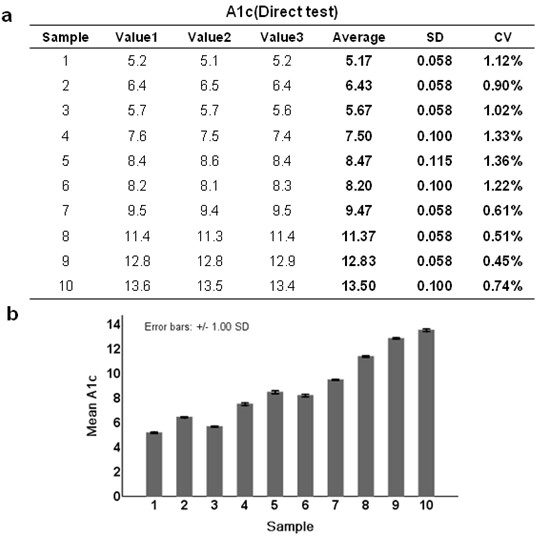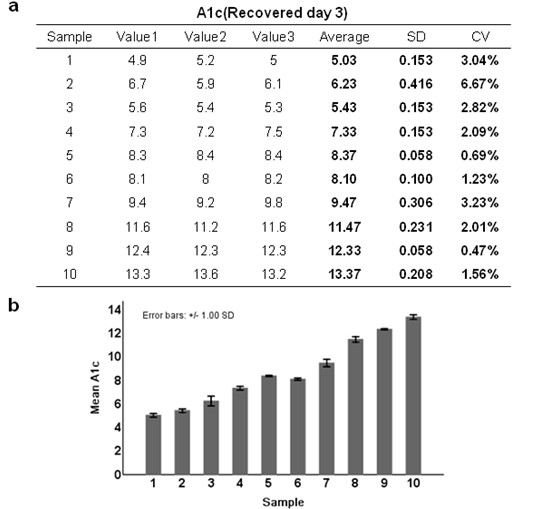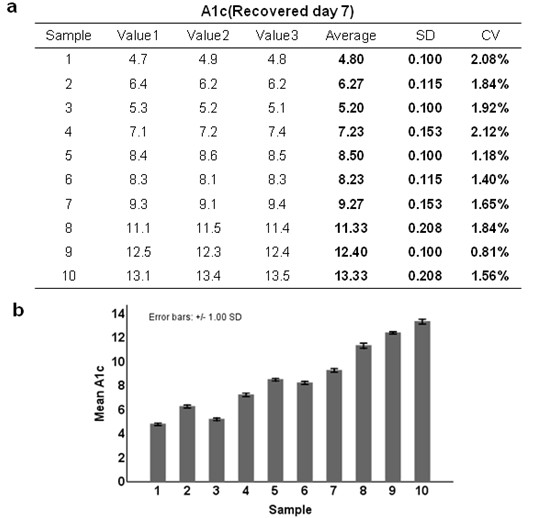Preparation and application method of filter paper collecting biological sample
A biological sample and filter paper technology, which is applied in the field of clinical disease diagnosis and detection, can solve the problems of low accuracy, low stability, and difficult elution of test results, and achieve the effects of easy elution detection, improved stability, and extended storage period
- Summary
- Abstract
- Description
- Claims
- Application Information
AI Technical Summary
Problems solved by technology
Method used
Image
Examples
Embodiment 1
[0076] Embodiment 1. The filter paper of the present invention was used to collect blood samples, the blood samples were air-dried naturally, and after being placed at room temperature for 3 days, the samples were eluted and recovered. The glycated hemoglobin in the sample was detected by enzyme-linked immunosorbent assay. Three replicate holes were made for each sample. The chart shows that the coefficient of variation among the multiple wells is small, and the value is highly similar to that of the control A (results are shown in the appendix figure 2 ).
Embodiment 2
[0077] Embodiment 2. Blood samples were collected with the filter paper of the present invention, air-dried naturally, left at room temperature for 7 days, and the samples were eluted and recovered. The glycated hemoglobin in the sample was detected by enzyme-linked immunosorbent assay. Three replicate holes were made for each sample. The chart shows that the coefficient of variation among the multiple wells is small, and the value is highly similar to that of the control A (results are shown in the appendix image 3 ).
Embodiment 3
[0078] Embodiment 3. Blood samples were collected by using the filter paper of the present invention, air-dried naturally, left at room temperature for 11 days, and the samples were eluted and recovered. Then use the enzyme-linked immunosorbent assay to detect the glycated hemoglobin in the sample, and make three duplicate holes for each sample. The chart shows that the coefficient of variation among the multiple wells is small, and the value is highly similar to that of the control A (results are shown in the appendix Figure 4 ).
[0079] Ethylenediaminetetraacetic acid, commonly known as EDTA, is an organic compound. It is a hexadentate ligand that can combine with metal ions such as Mg2+, Ca2+, Mn2+, and Fe2+. Since the action of most nucleases and some proteases requires Mg2+, it can be used as an inhibitor of nucleases and proteases. Ethylenediaminetetraacetic acid is an important complexing agent with a wide range of uses, such as bleaching and fixing solutions, dyei...
PUM
 Login to View More
Login to View More Abstract
Description
Claims
Application Information
 Login to View More
Login to View More - R&D Engineer
- R&D Manager
- IP Professional
- Industry Leading Data Capabilities
- Powerful AI technology
- Patent DNA Extraction
Browse by: Latest US Patents, China's latest patents, Technical Efficacy Thesaurus, Application Domain, Technology Topic, Popular Technical Reports.
© 2024 PatSnap. All rights reserved.Legal|Privacy policy|Modern Slavery Act Transparency Statement|Sitemap|About US| Contact US: help@patsnap.com










